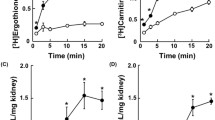Summary
The experiments reported in this paper aim at characterizing the carboxylic acid transport, the interactions of pyruvate and citrate with their transport sites and specificity. The study of these carriers was performed using isotopic solutes for the influx measurements in brush-border membrane vesicles under zerotrans conditions where the membrane potential was abolished with KCl preloading with valinomycin or equilibrium exchange conditions and Δψ=0.
Under zerotrans condition and Δψ=0, the influence of pyruvate concentrations on its initial rates of transport revealed the existence of two families of pyruvate transport sites, one with a high affinity for pyruvate (K t =88 μm) and a low affinity for sodium (K t =57.7mm) (site I), the second one with a low affinity for pyruvate (K t =6.1mm) and a high affinity for sodium (K t =23.9mm) (site II). The coupling factor [Na]/[pyruvate] stoichiometry were determined at 0.25mm and 8mm pyruvate and estimated at 1.8 for site I, and 3 when the first and the second sites transport simultaneously.
Under chemical equilibrium (Δψ≅0) single isotopic labeling, transport kinetics of pyruvate carrier systems have shown a double interaction of pyruvate with the transporter; the sodium/pyruvate stoichiometry also expressed according to a Hill plot representation wasn=1.7. The direct method of measuring Na+/pyruvate stoichiometry from double labeling kinetics and isotopic exchange, for a time course, gives an=1.67.
Studies of transport specificity, indicate that the absence of inhibition of lactate transport by citrate and the existence of competitive inhibition of lactate and citrate transports by pyruvate leads to the conclusion that the low pyruvate affinity site can be attributed to the citrate carrier (tricarboxylate) and the high pyruvate affinity site to the lactate carrier (monocarboxylate).
Similar content being viewed by others
References
Barac-Nieto, M., Murer, H., Kinne, R. 1980. Lactate-sodium cotransport in rat renal brush border membrane.Am. J. Physiol. 239:F496-F506
Dixon, M., Webb, E.C. 1964. Enzymes. (2nd ed.) Academic, New York
Fritzsch, G., Haase, W., Rumrich, G., Fasold, H., Ullrich, K.J. 1984. A stopped flow capillary perfusion method to evaluate contraluminal transport parameters of methylsuccinate from interstitium into renal proximal tubules cells.Pfluegers Arch. 400:250–256
Garay, R.P., Garrahan, P.J. 1973. The interactions of sodium and potassium with the sodium pump in red cells.J. Physiol. (London) 231:297–325
Hildman, B., Storelli, C., Haase, W., Barac-Nieto, M., Murer, M. 1980. Sodium ion/l-lactate cotransport in rabbit small-intestinal brush border membrane vesicles.Biochem. J. 186:169–176
Hopfer, U., Groseclose, R. 1980. The mechanism of Na+-dependentd-glucose transport.J. Biol. Chem. 255:4453–4462
Jorgensen, K.E., Sheikh, M.I. 1984. Renal transport of monocarboxylic acid.Biochem. J. 223:803–807
Jorgensen, K.E., Sheikh, M.I. 1988. Transport of pyruvate by luminal membrane vesicles from pars convoluta and pars recta of rabbit proximal tubule.Biochim. Biophys. Acta 938:345–352
Kippen, I., Hirayama, B., Klinenberg, J.R., Wright, E.M. 1979. Transport of tricarboxylic acid cycle intermediates by membrane vesicles from renal brush border.Proc. Natl. Acad. Sci. USA 76 (7):3397–3400
Mengual, R., Leblanc, G., Sudaka, P. 1983. The mechanism of Na+ l-lactate cotransport by brush border membrane vesicles from horse kidney.J. Biol. Chem. 288 (24):15071–15078
Mengual, R., Sudaka, P. 1983. The mechanism of Na+-l-lactate cotransport by brush border membrane vesicles.J. Membrane Biol. 71:163–171
Murer, M., Smaj, P. 1986. Transport studies in plasma membrane vesicles isolated from renal cortex.Kidney Int. 30:171–186
Nord, E., Wright, S.H., Kippen, I., Wright, E.M. 1982. Pathways for carboxylic acid transport by rabbit renal brush border membrane vesicles.Am. J. Physiol. 243:F456-F462
Nord, E.P., Wright, S.H., Kippen, I., Wright, E.M. 1983. Specificity of the Na+-dependent monocarboxylic acid transport pathway in rabbit renal brush border membranes.J. Membrane Biol. 72:213–221
Poiree, J.C., Vannier, C., Sudaka, P., Fehlmann, M. 1978. Glucose transport by horse kidney brush borders. I. Transport properties of brush border membrane closed vesicles.Biochimie 60:645–651
Samarzija, I., Molnar, V., Frömter, E. 1981. The stoichiometry of Na+ coupled anions absorption across the brush border membrane of rat renal proximal tubule.In: Advances in Physiological Sciences: Kidney and Body Fluids. L. Takacs, editor. Vol. 11, pp. 419–423. Pergamon, Oxford-New York-Sidney-Paris-Frankfurt
Segel, I.H. 1975. Enzyme Kinetics. pp. 1–945. John Wiley and Sons, New York
Sheridan, E., Rumrich, G., Ullrich, K.J. 1983. Reabsorption of dicarboxylic acids from the proximal convolution of rat kidney.Pfluegers Arch. 399:18–28
Turner, R.J. 1983. Quantitative studies of cotransport systems: Models and vesicles.J. Membrane Biol. 76:1–15
Ullrich, K.J., Fasold, H., Rumrich, G. Kloss, S. 1984. Secretion and contraluminal uptake of dicarboxylic acids in the proximal convolution of rat kidney.Pfluegers Arch. 400:241–249
Ullrich, K.J., Rumrich, G., Kloss, S. 1982. Reabsorption of monocarboxylic acids in the proximal tubule of the rat kidney.Pfluegers Arch. 395:212–219
Wright, S.H., Hirayama, B., Kaunitz, J.D., Kippen, I., Wright, E.M. 1983. Kinetics of sodium succinate cotransport across renal brush border membranes.J. Biol. Chem. 258:5456–5462
Wright, S.H., Kippen, I., Klineberg, R.J., Wright, E.M. 1980. Specificity of transport system for tricarboxylic acid cycle intermediates in renal brush borders.J. Membrane Biol. 57:73–82
Wright, S.H., Kippen, I., Wright, E.M. 1982. Stoichiometry of Na-Succinate cotransport in renal brush border membranes.J. Biol. Chem. 257:1773–1778
Wright, S.H., Krasne, S., Kippen, I., Wright, E.M. 1981. Na+-dependent transport of tricarboxylic acid cycle intermediates by renal brush border membrane: Effects on fluorescence of a potential sensitive cyanine dye.Biochim. Biophys. Acta 640:767–778
Author information
Authors and Affiliations
Rights and permissions
About this article
Cite this article
Mengual, R., Claude-Schlageter, MH., Poiree, JC. et al. Characterization of sodium and pyruvate interactions of the two carrier systems specific of mono- and di- or tricarboxylic acids by renal brush-border membrane vesicles. J. Membrain Biol. 108, 197–205 (1989). https://doi.org/10.1007/BF01871734
Received:
Revised:
Issue Date:
DOI: https://doi.org/10.1007/BF01871734




